

World population-food supply balance is becoming increasingly unstable, study finds. Researchers report that as the world population increases and food demand has grown, globalization of trade has made the food supply more sensitive to environmental and market fluctuations.
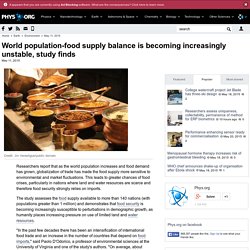
This leads to greater chances of food crises, particularly in nations where land and water resources are scarce and therefore food security strongly relies on imports. The study assesses the food supply available to more than 140 nations (with populations greater than 1 million) and demonstrates that food security is becoming increasingly susceptible to perturbations in demographic growth, as humanity places increasing pressure on use of limited land and water resources.
To address the global food crisis, we have to address the power of big agribusiness. There is plenty of evidence that the livelihoods of farmers and communities can be improved, and that agroecology can deliver a huge range of other benefits.
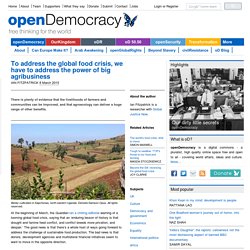
Barley cultivation in Kapchorwa, north-eastern Uganda. Demotix/Samson Opus. All rights reserved.At the beginning of March, the Guardian ran a chilling editorial warning of a looming global food crisis, saying that an ‘enduring lesson of history is that drought and famine feed conflict, and conflict breeds more privation, and despair.’ UN: Food Challenge At Worst Level Since World War II. UNITED NATIONS (AP) — The World Food Program is confronting its worst challenge since World War II in trying to tackle five top-level humanitarian crises at the same time, the head of the U.N. agency said Friday.

Ertharin Cousin said in an interview with The Associated Press that the five crises — in Syria, Iraq, Central African Republic, South Sudan, and the Ebola epidemic in West Africa — currently require large-scale operations by WFP and other humanitarian agencies. In addition, she said, WFP is doing preparatory work for a potential scale-up in food assistance to four other countries where there is growing political instability — Yemen, Nigeria, Ukraine and Libya. Cousin said the demands are overwhelming the donor community and as a result WFP had to cut food assistance to six million Syrians inside and outside the country by 30 percent in January. "We have more crises that require surge operations of the humanitarian community, and WFP specifically, since World War II," she said. Latest climate change battle may center on food pyramid.
The political clash over climate change has entered new territory that does not involve a massive oil pipeline or a subsidy for renewable energy, but a quaint federal chart that tries to nudge Americans toward a healthy diet.
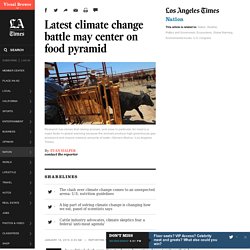
The food pyramid, that 3-decade-old backbone of grade-school nutrition lessons, has become a test case of how far the Obama administration is willing to push its global warming agenda. The unexpected debate began with a suggestion by a prominent panel of government scientists: The food pyramid — recently refashioned in the shape of a dinner plate — could be reworked to consider the heavy carbon impact of raising animals for meat, they said. A growing body of research has found that meat animals, and cows, in particular, with their belching of greenhouse gases, trampling of the landscape and need for massive amounts of water, are a major factor in global warming.
But the stakes are high when it comes to steak. Matz is no climate skeptic. Evan.halper@latimes.com. The World’s Second-Biggest Food Exporter Declares War on Livestock Antibiotics. Insecticides put world food supplies at risk, say scientists. The world’s most widely used insecticides have contaminated the environment across the planet so pervasively that global food production is at risk, according to a comprehensive scientific assessment of the chemicals’ impacts.

Democracy and Diversity Can Mend Broken Food Systems - Final Diagnosis from UN Right to Food Expert. GENEVA – The United Nations Special Rapporteur on the right to food, Olivier De Schutter, today called for the world’s food systems to be radically and democratically redesigned to ensure the human right to adequate food and freedom from hunger.

“The eradication of hunger and malnutrition is an achievable goal. However, it will not be enough to refine the logic of our food systems – it must instead be reversed,” Mr. The Global Food Challenge Explained in 18 Graphics. This post is part of WRI's blog series, Creating a Sustainable Food Future.
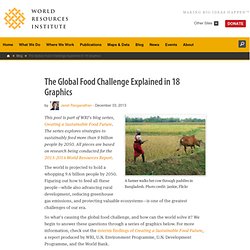
The series explores strategies to sustainably feed more than 9 billion people by 2050. All pieces are based on research being conducted for the 2013-2014 World Resources Report. The world is projected to hold a whopping 9.6 billion people by 2050. Figuring out how to feed all these people—while also advancing rural development, reducing greenhouse gas emissions, and protecting valuable ecosystems—is one of the greatest challenges of our era. If You Want a Glimpse of the Future Food Wars, Look to Hawaii. [Insert normal verbiage about this not being in support of Monsanto et. al. here] I'm wondering whether or not developing drought, pest & disease resistant strains is going to be an important part of making sure our food supply survives the rather uncertain future presented to us by climate change.

Given the political orientation of most of these people, and given the fact that they live on an island that is pretty sensitive to rising sea levels, it seems even more counter-productive for them than it is for most people to do this, but I'm also not a climatologist or a geneticist, so what do I know? Then again, I'm betting that my ruminations above represent a somewhat more reasoned view than the average state legislator in Hawaii has on the topic.
Visited Kauai two months ago and learned how 9 year old girls are already menstruating, and cancer is most prevalent among locals near the GMO farms. Learned how exactly? Conflict Kitchen puts peace on the table. During more than a decade of working in parts of the world affected by conflict, I have never been far from sharing food.
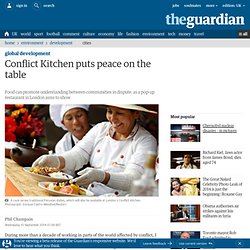
As an outsider, invariably I have been the guest at a restaurant or the family home of a relative stranger. On occasions, food itself has been the subject of argument. In 2008, Lebanese chefs created the world’s largest hummus plate in Beirut and decorated it with the Lebanese flag during a row over traditional dishes. Armenians have taken steps to safeguard what they believe to be the Armenian lineage of tolma (stuffed vine leaves or other vegetables), which are frequently also served in Turkey (where they are known as dolma). And on the other side of the conflict divide, Azerbaijan’s culinary watchdog the National Cuisine Centre has not been reluctant to persuade people that Armenian cuisine is in fact Azeri cuisine. But it can also be an important part of deepening understanding.
Open Source Farming: A Renaissance Man Tackles the Food Crisis. (Photo: Dahr Jamail)Given Anthropogenic Climate Disruption and our dwindling capacities for producing enough healthy food, a cutting-edge farming technique that dramatically increases produce yields from a design engineer in Port Townsend, Washington, may well already be filling a critical void.

The news about our global food supply is not good. Around the world - from the Middle East, across much of Africa, to California - wars over water and food are already occurring. Billions of people already lack adequate supplies of potable water on a daily basis, and by 2030, nearly half the world's population will live in "water-stressed" areas, according to the Organization for Economic Cooperation and Development's Environmental Outlook 2030 Report. Massachusetts to Implement Most Ambitious Food Waste Ban in U.S. We’ve mentioned that food waste is an expensive, environmental nightmare. Americans waste 40 percent of the food that’s produced each year to the tune of $165 billion. One state has figured out a way to make this stop — by making it a crime. Starting in October, Massachusetts’s biggest food wasters will no longer be able to send their unwanted food to the landfills, NPR reports.
The ban, recently finalized by Gov. Deval Patrick, targets places that produce more than a ton of organic food waste per week, such as universities, hotels, grocery stores, sporting and entertainment venues and other manufacturers. Peru's isolated Mashco-Piro tribe 'asks for food' 20 August 2013Last updated at 08:46 ET The tribe was filmed making contact with another remote community Members of one of the most isolated tribes on Earth have briefly emerged from the Peruvian jungle to ask for food, according to local activists.
A group from the Mashco-Piro tribe made contact with villagers, apparently sparking a tense stand-off. Has financial speculation in food commodity markets increased food prices? By Noemi Pace, Andrew Seal, Anthony Costello Noemi Pace is research fellow at University College London, Centre for International Health and Development. She was previously a visiting researcher at the Centre for Health Policy at Stanford University and the Sphere Institute in the US. She holds a B.A. in Economics, a Master Degree in Development Economics and a Ph.D. in Economic Theory from the University of Rome "Tor Vergata". Andrew Seal is a Lecturer in International Nutrition at UCL CIHD. The world’s debt-for-food scandal. STAND by for food riots. I just don’t know where. According to the United Nations Food and Agricultural Organisation (FAO), riots are most likely to occur when its food price index exceeds 210.
It is currently at 216.
Wars for food. Chocolate. Food Riots. Climate. Plan Act React. Analysis. Maps. Long term crisis? Effects for poor countries. Biofuel. Meat consumption. 1% + Banksters + Speculators. Food price speculation. UN + GOVs + NGOs.